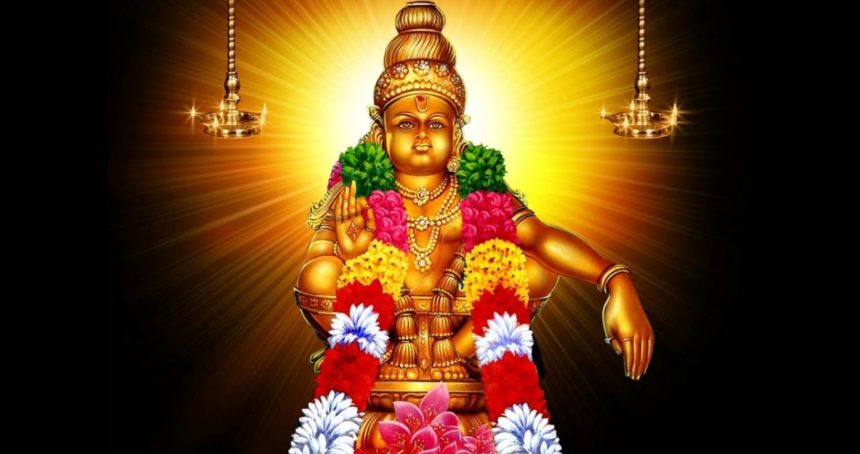Ayyappa puja which I was witness to during my younger days has resurfaced in my mind thanks to the Sabarimala crisis.
Memories of Ayyappa Puja

In childhood, I went to Sabarimala a total of six times. Mandala vratam is not an issue when you are a child and hence this was no big deal. After puberty, the circumstances of my family changed dramatically and we could no longer afford the trip to Kerala from Calcutta. It took two days to reach Madras by train. Then another 24 hours to get to Cochin and then onwards to Mala. Also, life circumstances remained hard for decades and the mandala vratam was impossible to maintain. Rather than do it half-heartedly or by hedging the vows, I decided to go only when I could do the full vratam, as it should be done. Then the crowds happened at Mala as they did at Tirupati and all desire to go dwindled. Also, Nataraja had marked me as his own, and it was not such a big deprivation. Or so I thought. But this uproar over Ayyappa showed me I am a Malayali after all in my bones and I feel deeply angry over this nonsense playing out between an Asuric establishment on one hand and cowards for leaders on the others.

In the years that I used to be in Calcutta, the Mandala season used to have Ayyappa pujas on Saturday. Small groups of devotees would gather in smaller rooms in front of pictures like the one shown above. There was probably Guruvayoor represented too and some Shiva kshetram. The Malayali Hindu community was not resource-abundant and even an Ayyappa temple of our own was not possible. This cramped devotion was all that was feasible. But for three hours or so, there was chanting, there was puja, there was shared bhakti. One or two of the men present had taken the Mala and they were going to Sabarimala. That represented a significant investment of time and resources as mentioned earlier. Flights were looked upon in the 1970s as some sort of fairy tale. A person who had actually flown was hence a person of consequence. One year we had six swamis going to Mala and that was a great event.
Now that I am the age of the men who used to be the predominant group in those gatherings, I can retrospectively understand what they were going through. There was ineffable sadness, a silent wail for all that was lost and never coming back, for Nallukettu Tharavads that had to be sold, for krishi that they could no longer do, for sarpa kaavus that children were uncomprehending about, for clean air to breathe and flowing rivers to bathe in, and above all for the incomparable greenery of Kerala. The plan was to go back after retirement. Everybody said so. Everybody knew that was not going to happen. This was their lot. Melancholy used to surge within the group in ten minutes. Ayyappa puja on Shaniyaiccha was their last link to a lost life, and the celebration was as much mourning and acknowledgement of reality as it was of an obvious and simple spiritual faith.
Then there was the Thullal – the Dancing Fit that used to come upon some men. The chants would cause them to become excited and they would jump up and down, go round in circles until they fell down. It was noticeable that nobody ever got hurt when they flailed about like this. Some men would go completely out of control and the fellow devotees would grab them and apply bhasmam to their foreheads and chant the name of Ayyappa. That used to knock them flat on the ground where they would shiver and tremble till they recovered. It was taken for granted that this would happen and everybody had the shared knowledge of what to do when the Thullal began. Community vidya is a remarkable thing to see.
In hindsight, I see so much more. The Thullal used to come to certain men only. They were the pillars of the community, respected, respectable, looked up to, men who had held up the burden of responsibility and providing all their life. They never complained because that would break the spirit of those who looked up to them, but when the Thullal came upon them, they could let loose for once. Nobody consciously saw this. Like the Malay who runs amok with the family kris and is killed by the community, there is no shame in this. It is acceptable as a subconscious maneuver to release psychic tension. People used to say the deva was within them. I knew even as a child that was not so. They were good people, upright people, but not people of shakti. Most of them were very embarrassed after the episode was over. The women rarely came to these pujas because they too had the community vidya that the men should be left alone to resolve their grief. They did not want to see their men helpless and very wisely, and with great compassion, they conceded the space so that the man could unravel, put himself together and come back and shoulder his burden for the rest of the year. None of this was thought out. It was the way things were. It was the unconscious wisdom of samajam – community, and we have lost that completely.
I had forgotten most of this. But now the uproar over, Ayyappa has renewed all these memories. The Asuric Indian state is planning something unpardonable and ghastly at the Sannidhi of Ayyappa. All of these people will pay.
In those small rooms with those faded pictures, I was being forged with the fires of devotion and pain into what I am today.
Tigers of Ayyappa, Amrutasva Putras, come out and roar!
Swamiyeh Sharanam Ayyappa!

Leave a Reply